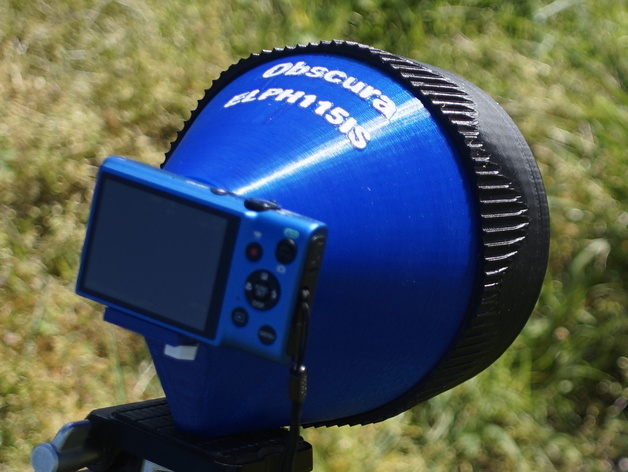
Camera Obscura for Canon PowerShot ELPH115IS
thingiverse
Just in time for Worldwide Pinhole Photography Day, here's a rather large attachment that allows a Canon PowerShot ELPH 115 IS to capture pinhole images. This attachment makes that little Canon project onto the 150mm diagonal screen built-into the unit, and the front section described here makes that screen the target of a pinhole obscura. You're probably wondering why use that Canon compact. Well, pinhole resolution is fundamentally limited by image size, so this big screen offers much better resolution than you can get directly using a pinhole with a small digital sensor. This particular Canon has an extra benefit: it can run CHDK, which means it can be programmed to do HDR capture sequences that can easily handle huge dynamic range caused by light falloff in ultrawide pinhole images. The photos of the pond, dandelions, and my 101-year-old aunt were all HDR sequences done with this rig. Printer Brand: MakerGear Printer: M2 Rafts: No Supports: No Resolution: 0.25mm Infill: only where needed Notes: The back took just under 3 hours to print in translucent blue PLA that roughly matches the Canon PowerShot color that mounts on it. The front also took about 3 hours to print, but in black PLA. Both the front and back should be done with at least two layers of outer shell; I tried using one layer, but rigidity simply wasn't good enough and lightproofing would have been more difficult. The screw that fits the tripod socket of the ELPH 115 IS takes very little time to print (I used white PLA), but it is a separate print to ensure the threads are as nice as possible. Putting it all together Translucent PLA is a bad choice indeed for camera parts supposed to be opaque, so I sanded both sides of the aluminum scrap to remove any coatings and further ensure the pinhole edge was clean. Finally, I used blue painter's tape to tape it into position from the inside of the front. Using the Camera Using the camera is pretty easy. The pinhole gives a field of view roughly comparable to a 24mm ultrawide lens on a full-frame DSLR, and everything is in focus (sort-of), so don't be afraid to get close to your subject. Remember that the PowerShot is always photographing the screen, so leave it in close-up mode no matter what distance the real subject is at. In practice, the metering will get you a shot that is at least 3 stops underexposed because the pinhole image is much brighter in the center -- and the camera only allows +/-2 stop exposure compensation. However, this is where the ability to use CHDK comes in handy. You can get CHDK for free from http://chdk.wikia.com/wiki/CHDK . Not only does it provide for manual exposure overrides, but you can also run Lua scripts for HDR capture that can get good detail everywhere, and then you can even-out the vignetting in postprocessing. For the examples here, I used a simple script to capture 3-5 image HDR sequences and then did a very crude tone mapping using layers in GIMP.
With this file you will be able to print Camera Obscura for Canon PowerShot ELPH115IS with your 3D printer. Click on the button and save the file on your computer to work, edit or customize your design. You can also find more 3D designs for printers on Camera Obscura for Canon PowerShot ELPH115IS.
